Navigation
- Install Director on Standalone Server
- Director Spinning Circle
- Director Configuration Script 💡
- Director and HDX Insight
- Director and Self-Service Password Reset
- Director Monitoring Database Grooming
- Director Single Sign On
- Director – Multiple XenDesktop Sites
- Director Process Monitoring
- Director Alerts and Notifications
- Director – SCOM Integration
- Director Tweaks
- Director – Saved Filters
- Director – Custom Reports
- Use Director 💡
Director on Standalone Server
If you are installing Director 7.12 on a standalone server, see Citrix CTX142260 Installing or Upgrading to Citrix Director 7.6.200
- If you intend to install Director on a standalone server, start with running AutoSelect.exe from the XenApp/XenDesktop 7.12 media.
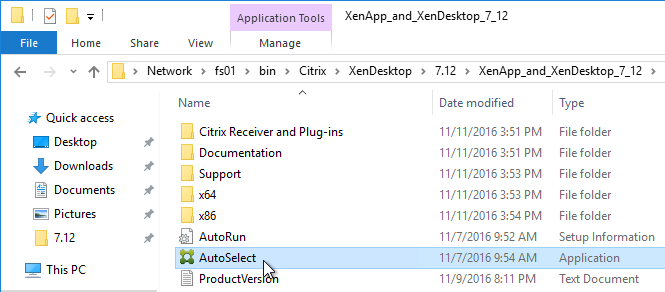
- On the right, click Citrix Director.

- In the Licensing Agreement page, select I have read, understand, and accept the terms, and click Next.
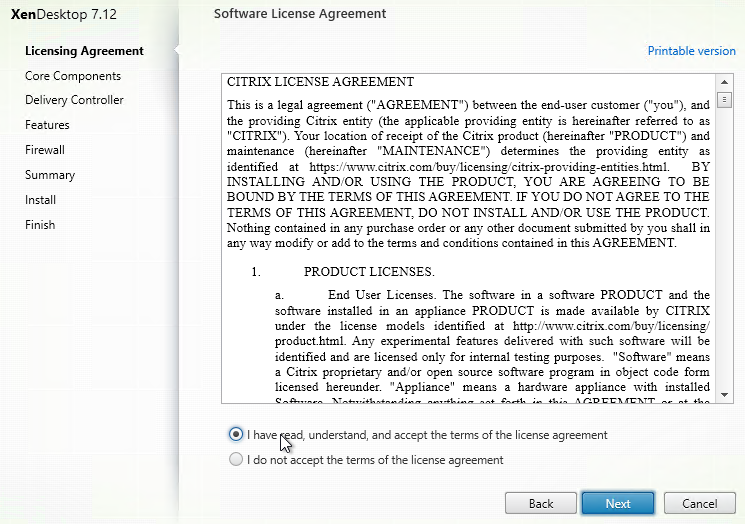
- In the Core Components page, click Next.
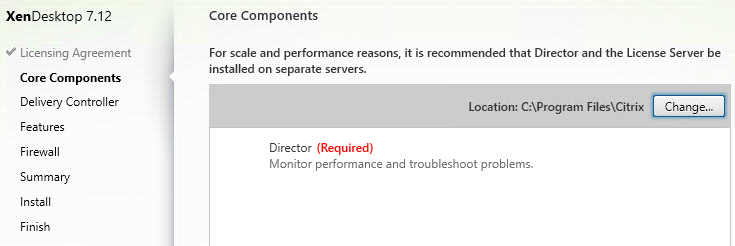
- In the Delivery Controller page, it will ask you for the location of one Controller in the farm. Only enter one Controller per farm. If you have multiple Director servers, each Director server can point to a different Controller in the farm. From Citrix Docs: Director automatically discovers all other Controllers in the same Site and falls back to those other Controllers if the Controller you specified fails. Click Test Connection, and then click Add.


- In the Features page, click Next.
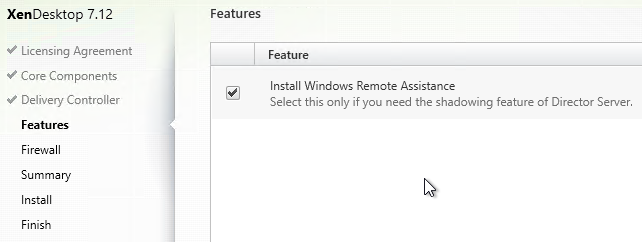
- In the Firewall page, click Next.
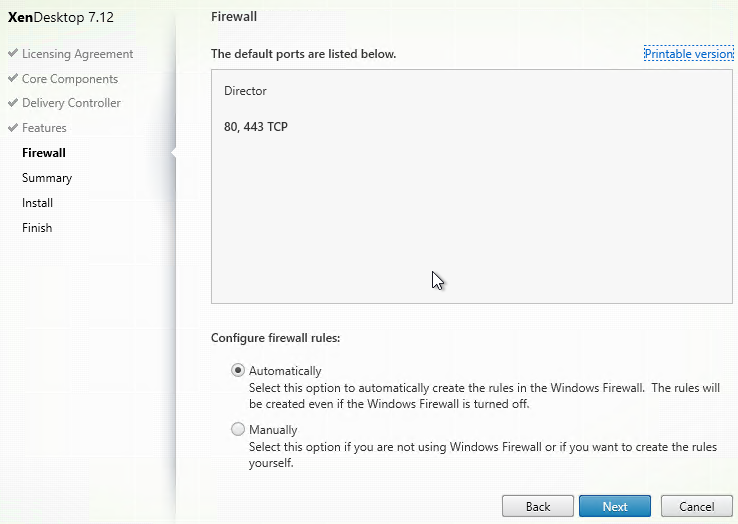
- In the Summary page, click Install.
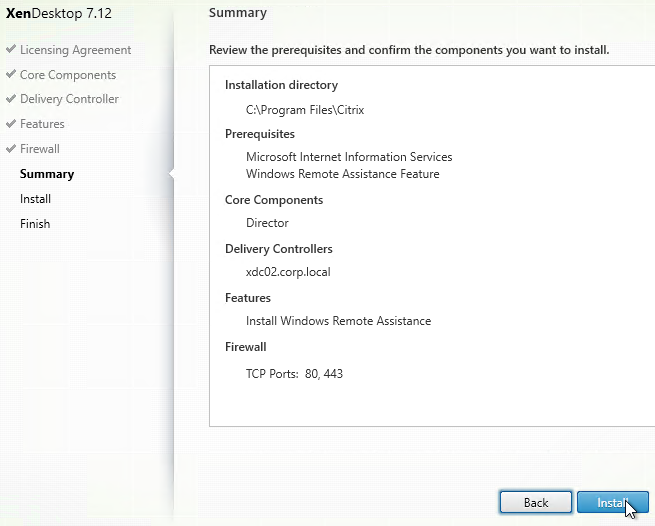
- In the Finish page, click Finish.
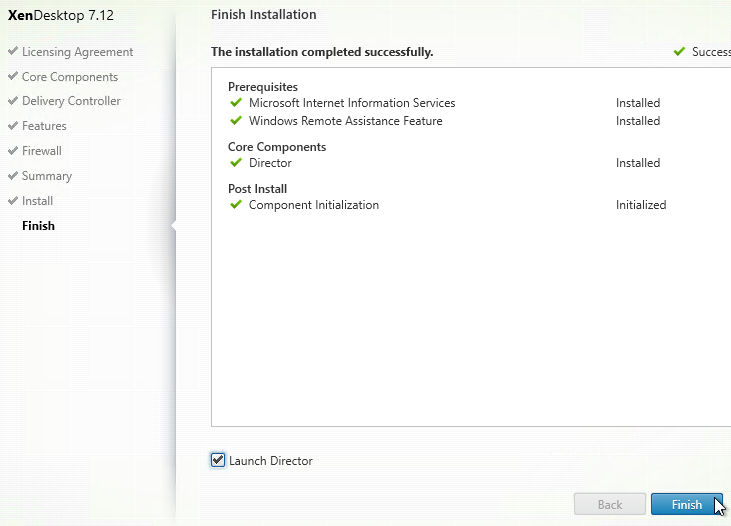
- In IIS Manager, go to Default Web Site > Director > Application Settings, find Service.AutoDiscoveryAddresses and make sure it points to one Controller in the farm, and not to localhost. From Citrix Docs: Director automatically discovers all other Controllers in the same Site and falls back to those other Controllers if the Controller you specified fails.
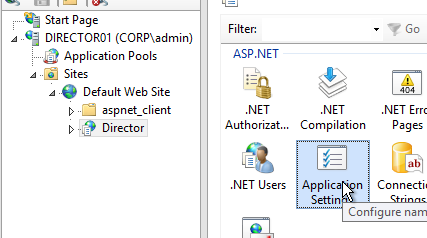
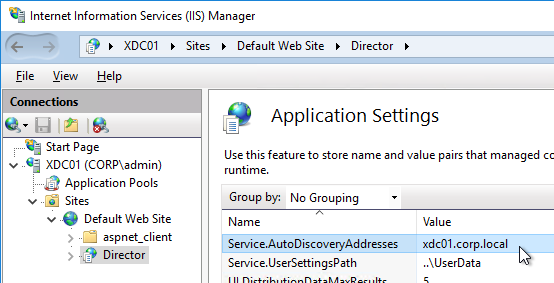
- If you built multiple Director servers, use NetScaler to load balance them.
- If you are upgrading Director, run C:\inetpub\wwwroot\Director\tools\DirectorConfig.exe /upgrade to complete the upgrade process.
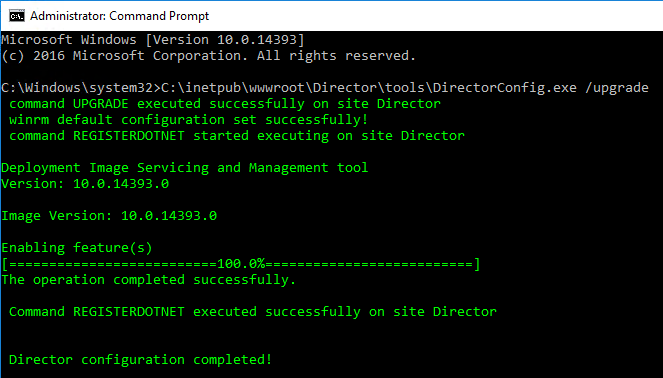
Director Spinning Circle
If after login the spinning circle doesn’t go away:
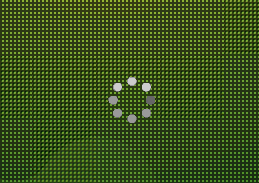
Do the following to fix it:
- Edit the file C:\inetpub\wwwroot\Director\web.config using an elevated text editor.
- Search for <serviceHostingEnvironment (line 273).
- Add the following attribute:
multipleSiteBindingsEnabled="true"
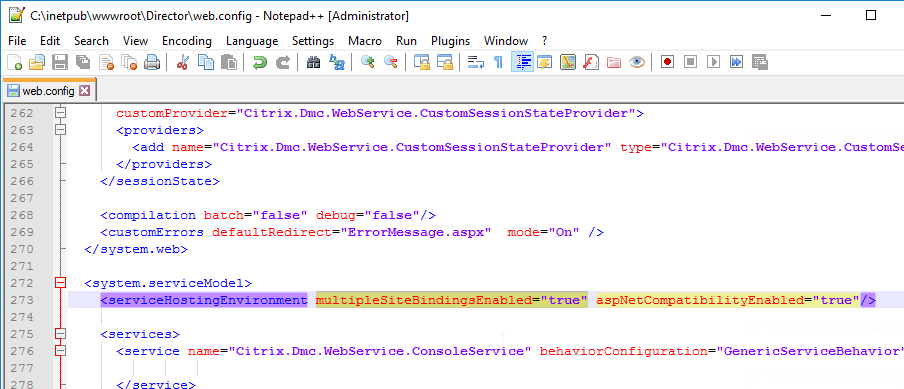
Also see CTX202564 Citrix Director Becomes Unresponsive after Submitting the Credentials when IIS X-Frame-Options is enabled
Director Configuration Script 💡
Johan Greefkes at Script for configuring Director at Citrix Discussions was kind enough to provide a script that does the following:
- Sets the XenDesktop Controllers that Director communicates with
- Disables SSL Check
- Sets Logon.aspx file to default to a domain name
- Adds a footer that displays the name of the Director server
Director and HDX Insight
You can connect Director to NetScaler Management & Analytics System (NetScaler MAS) or Citrix Insight Center to add Network tabs to Director’s Trends and Machine Details views. Citrix Blog Post Configure Director with NetScaler Management & Analytics System (MAS).

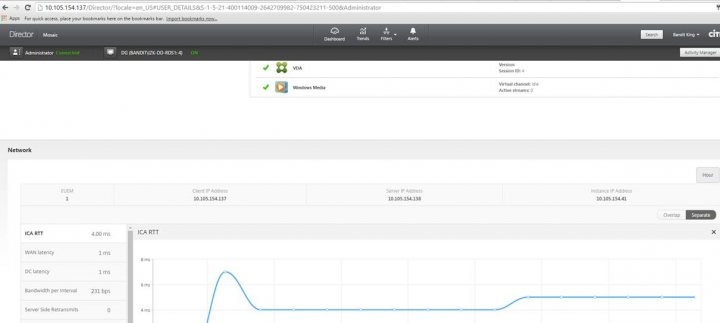
Director and Self-Service Password Reset (SSPR)
If you have XenApp/XenDesktop Platinum Edition, it’s possible to install SSPR on the Director server. See George Spiers Citrix Self-Service Password Reset for a detailed implementation guide.
However this might break Director, and all you will see is a spinning circle.

To fix it, in IIS Manager (inetmgr), edit the bindings of the Default Web Site, and Remove the HTTP 8080 binding. Or implement the multisitebinding fix.
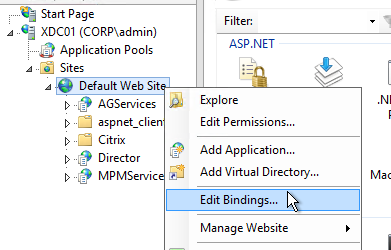

More info at Citrix Discussions Installing SSPR 1.0 appears to have broken Director 7.11 on same server.
Director Grooming
If XenDesktop is not Platinum Edition then all historical Director data is groomed at 30 days.
For XenDesktop/XenApp Platinum Edition, by default, most of the historical Director data is groomed at 90 days. This can be adjusted up to 367 days by running a PowerShell cmdlet.
- On a XenDesktop Delivery Controller, run PowerShell and run asnp Citrix.*

- Run Get-MonitorConfiguration to see the current grooming settings.

- Run Set-MonitorConfiguration to change the grooming settings.

Director Single Sign-on
You can configure Director to support Integrated Windows Authentication (Single Sign-on). Note: there seem to be issues when not connecting from the local machine or when connecting through a load balancer.
- Run IIS Manager. You can launch it from Server Manager (Tools menu), or from the Start Menu, or by running inetmgr.
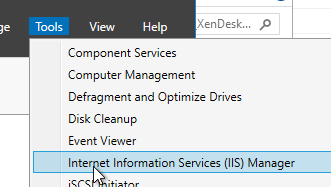
- On the left, expand Sites, expand Default Web Site, and click Director.
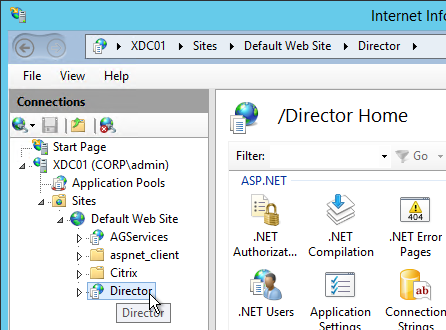
- In the middle, double-click Authentication in the IIS section.
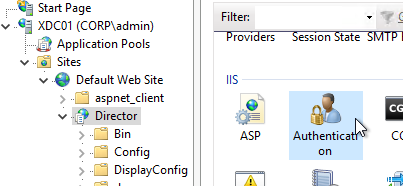
- Right-click Windows Authentication, and Enable it.
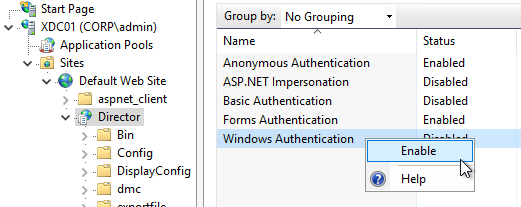
- Right-click Anonymous Authentication, and Disable it.

- Pass-through auth won’t work from another computer until you set the http SPN for the Director server. See Director 7.7 Windows Authentication not working with NS LB at Citrix Discussions.

- If Director is not installed on a Controller then you’ll need to configure Kerberos delegation.
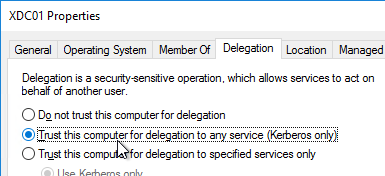
- If you are load balancing Director then additional config is required. See Director 7.7 Windows Authentication not working with NS LB at discussions.citrix.com for more info.
- Create an AD service account that will be used as the Director’s ApplicationPoolIdentity.
- Create SPN and link it to the service account.
setspn -S http/loadbalanced_URL domain\user
- Trust the user account for delegation to any service (Kerberos only) (trust the Director servers for delegation is not necessary in this case). You have to create the SPN before you can do this step.
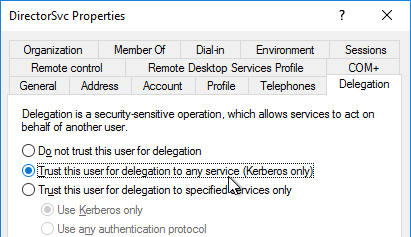
- In IIS manager, on the Application Pools (Director), specify the Identity as user we have created in step 1.
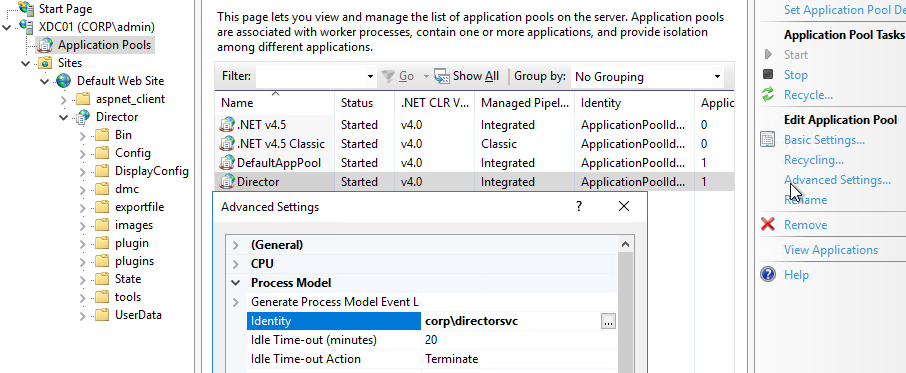
- In IIS manager, select Default Web Site and open the Configuration Editor.
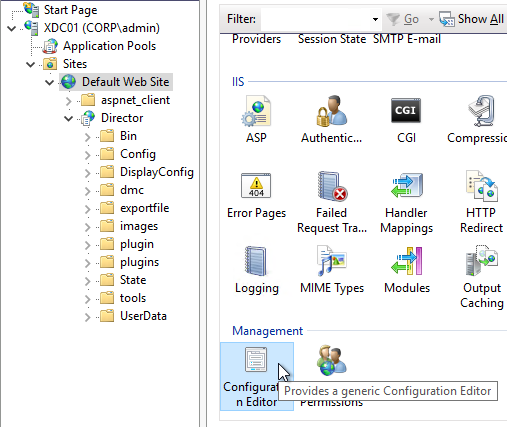
- Use the drop-down to navigate to the following section:
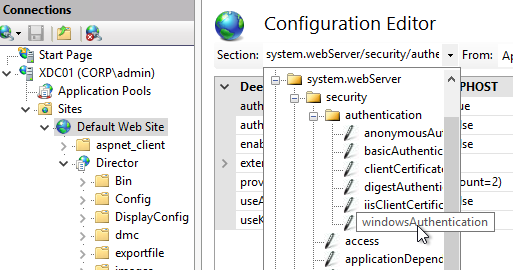
system.webServer/security/authentication/windowsAuthentication
- Set useAppPoolCredentials = True and useKernelMode = False. Click Apply on the top right.
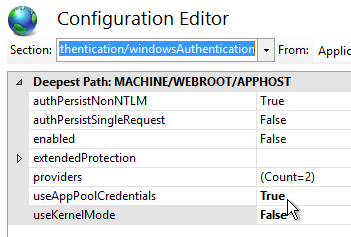
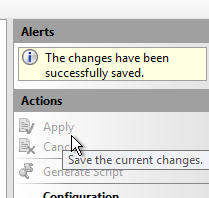
- When you connect to Director you will be automatically logged in. You can change the login account by first logging off.
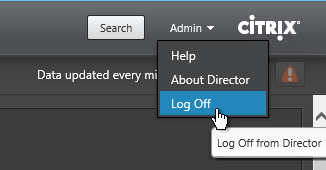
- Then change the drop-down to User credentials.
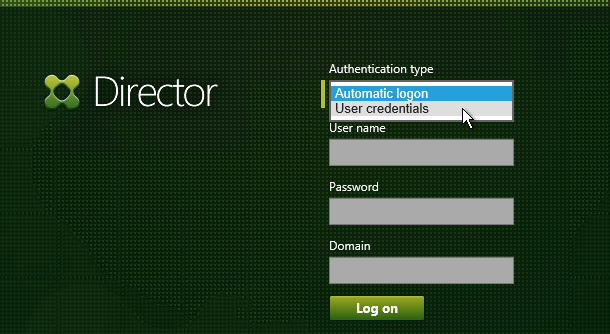
Director – Multiple XenDesktop Sites
- Run IIS Manager. You can launch it from Server Manager (Tools menu) or from the Start Menu or by running inetmgr.
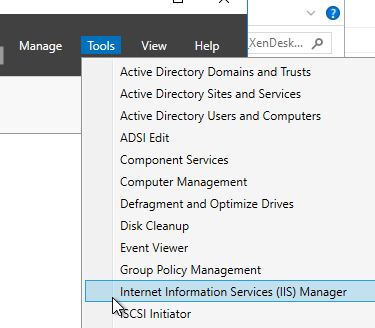
- On the left, expand Sites, expand Default Web Site, and click Director.
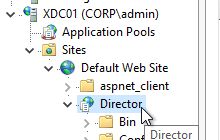
- In the middle pane, double-click Application Settings.
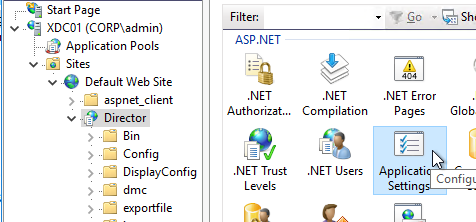
- Find the entry for Service.AutoDiscoveryAddresses and double-click it.
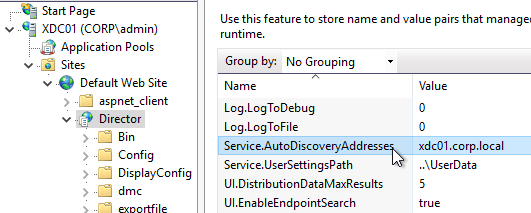
- If Director is installed on a Controller, localhost should already be entered.
- Add a comma and the NetBIOS name of one of the controllers in the 2nd XenDesktop Site (farm). Only enter one Controller name. If you have multiple Director servers, you can point each Director server to a different Controller in the 2nd XenDesktop Site (farm). From Citrix Docs: Director automatically discovers all other Controllers in the same Site and falls back to those other Controllers if the Controller you specified fails.
Director Process Monitoring
Director 7.11 adds Process Monitoring, which is detailed in Citrix Blog Post Citrix Director: CPU, Memory Usage and Process Information.
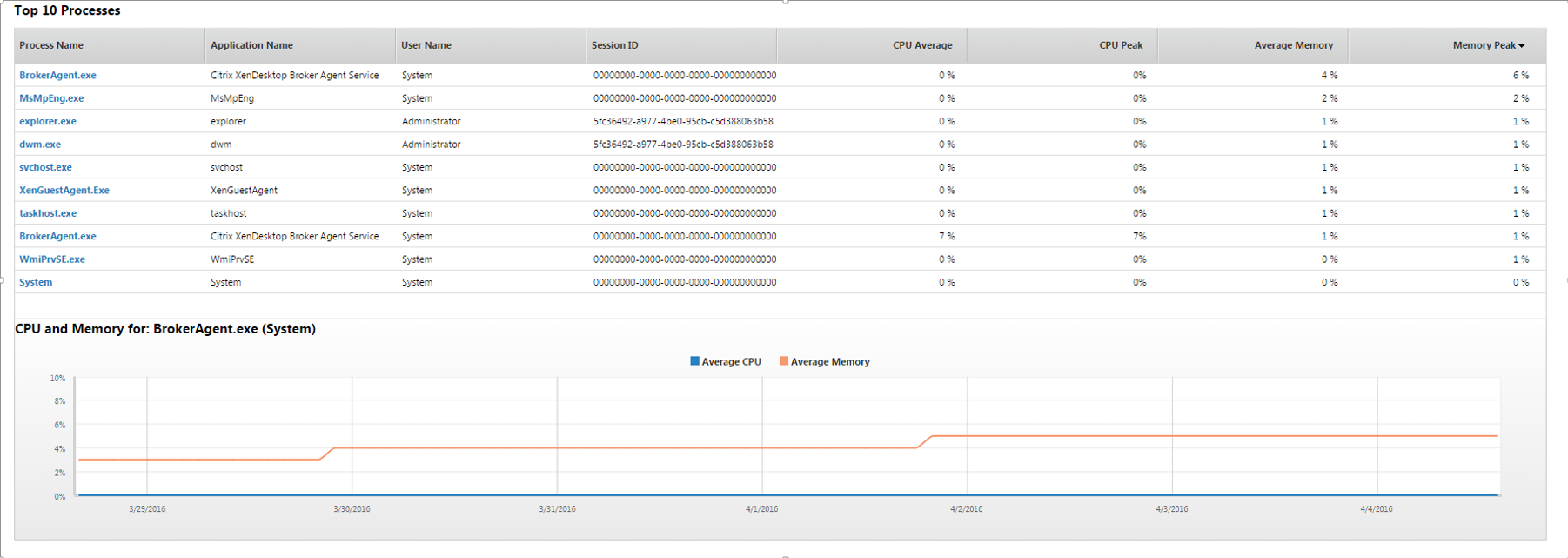
This feature is disabled by default. To enable it, configure the Enable process monitoring setting in a Citrix Policy. For Citrix Policies in a GPO, find this setting in the computer half of the GPO. Note: this setting could significantly increase the size of the Monitoring database.
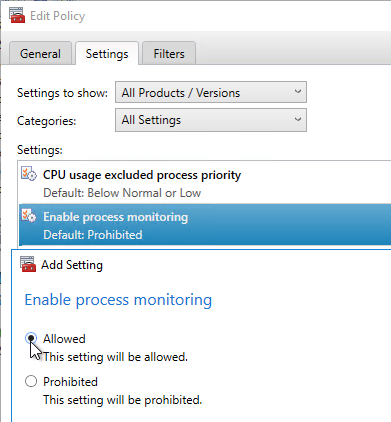
Director Alerts and Notifications
Director supports alert conditions and email notifications. This feature requires XenApp/XenDesktop to be licensed with Platinum Edition. See Citrix Blog Post Configuring & Managing Alerts and Notifications Using Director for more information.
Director 7.11 adds CPU, Memory, and ICT RTT alerts. Citrix Blog Post 7 New Categories in Director for Proactive Notifications & Alerts
To configure alerts:
- While logged into Director, at the top of the page click the Alerts button.

- Switch to the Email Server Configuration tab.
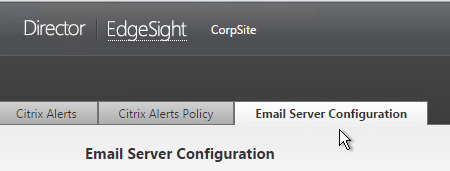
- Enter your SMTP information and click Send Test Message. Then click Save.
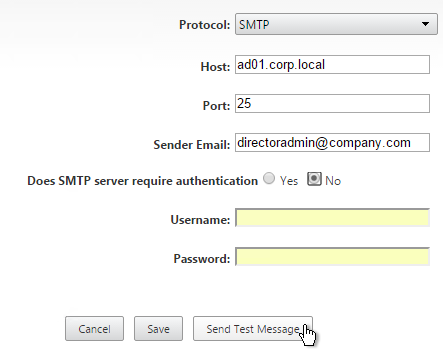
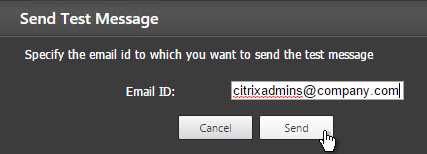
- Switch to the Citrix Alerts Policy tab.
- There are four high-level categories of alerts: Site Policy, Delivery Group Policy, Server OS Policy, and User Policy. Click whichever one you want to configure.
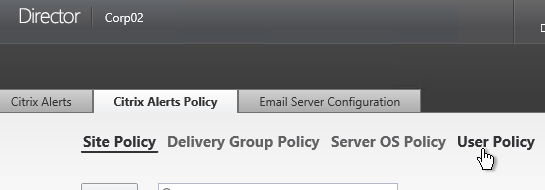
- Then click Create.
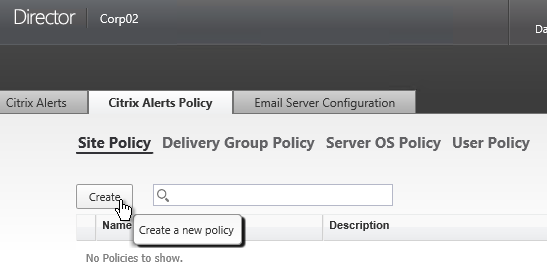
- Give the alert a name.
- On the bottom left, select a condition and enter thresholds.
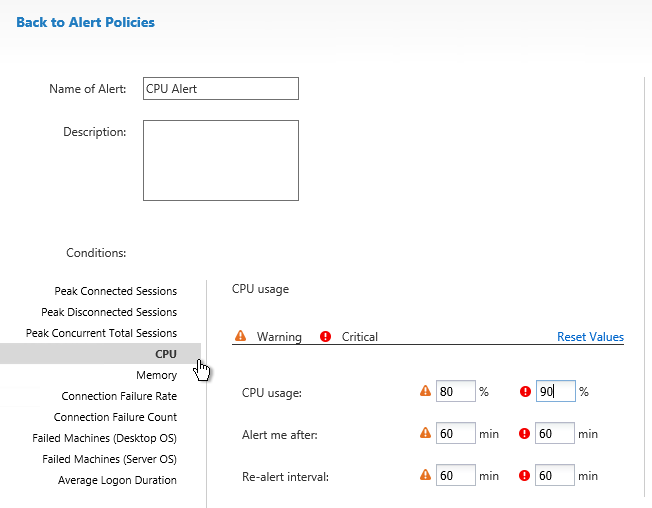
- On the bottom right, in the Notifications preferences section, click Add.
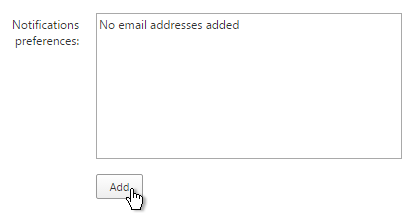
- Enter an email address and click Add.

- Click Save when done. Feel free to create more alerts and notifications.

- For Server OS and User Policy, there are new ICA RTT alerts. See Citrix Blog Post 7 New Categories in Director for Proactive Notifications & Alerts for details on the new alerts in 7.11.
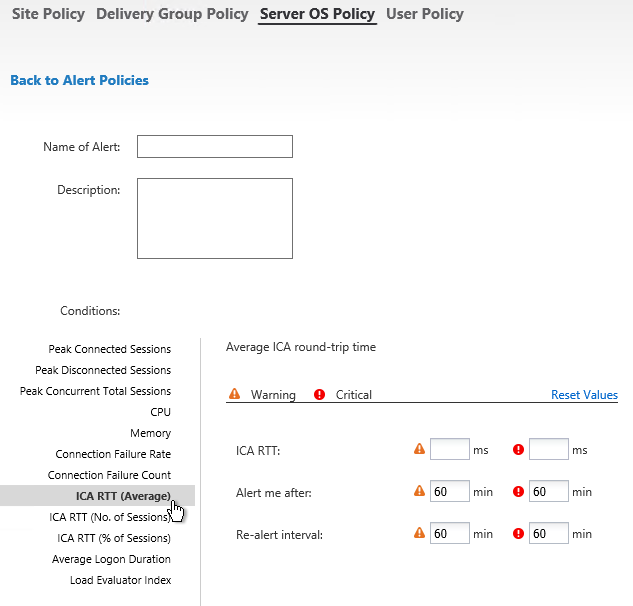
- In Director 7.12 and newer, you can configure alerts to generate an SNMP trap. This is configured in PowerShell as described at Configure alerts policies with SNMP traps at Citrix Docs.
Set-MonitorNotificationSnmpServerConfiguration #see Docs for parameter details Set-MonitorNotificationPolicy -IsSnmpEnabled $true -Uid <Policy ID>
- Citrix has an experimental Desktop Notification Tool. See Citrix Blog Post Desktop Notification Tool For Citrix XenDesktop.

Director Alerts can be configured with a WebHook that allows Octoblu to perform actions when a Director Alert occurs. See Configure alerts policies with Octoblu webhooks at Citrix Docs for details.
Set-MonitorNotificationPolicy –Uid 5 –Webhook <Webhook URL>
Director – SCOM Integration
Director 7.8 and newer can display alerts from System Center Operations Manager 2012 R2. This feature requires XenApp/XenDesktop Platinum Edition.
- See Configure SCOM integration at Citrix Docs for detailed configuration instructions. Also see Marius Sandbu Integrating Citrix XenDesktop 7.7 and System Center Operations Manager.
- If Director server or System Center Operations Manager server is 2008 R2, then login to the 2008 R2 server, open PowerShell and run Enable-PSRemoting. Yes to everything. This is not needed on Windows Server 2012 R2 servers.
- On Director server, run C:\inetpub\wwwroot\Director\tools\DirectorConfig.exe /configscom
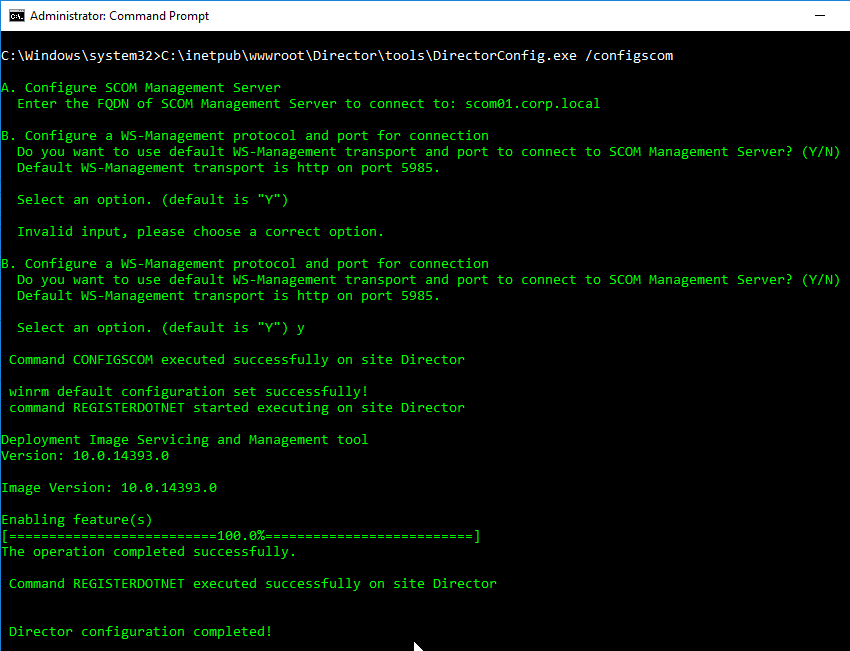
- FYI, the DirectorConfig.exe /configscom command enables the following features on the Director server: /FeatureName:IIS-NetFxExtensibility45 /FeatureName:IIS-ASPNET45 /FeatureName:WCF-HTTP-Activation45
- FYI, the System Center Operations Manager server is listed in IIS Manager at Default Web Site > Director > Application Settings (middle pane) > Connector.SCOM.ManagementServer.
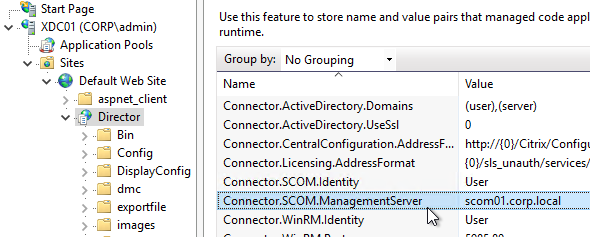
- On the System Center Operations Manager server, edit Remote Management Users local group and add Citrix Admins and other Director users.
- In System Center Operations Manager Console, go to Administration > User Roles and edit Operations Manager Operators. Add the Citrix Admins and other Director users.
- See Citrix Blog Post SCOM Alerts in Citrix Director for information on how to view System Center Operations Manager alerts in Director.
Director Tweaks
Prepopulate the domain field
From http://www.xenblog.dk/?p=33: On the Controllers having the Director role installed, locate and edit the ‘LogOn.aspx’ file. By default you can find it at C:\inetpub\wwwroot\Director\Logon.aspx
In line 450 you will have the following. To find the line, search for ID=”Domain”. Note: onblur and onfocus attributes were added in newer versions of Director.
<asp:TextBox ID="Domain" runat="server" CssClass="text-box" onfocus="showIndicator(this);" onblur="hideIndicator(this);"></asp:TextBox>
In the ID=”Domain” element, insert a Text attribute and set it to your domain name. Don’t change or add any other attributes. Save the file.
<asp:TextBox ID="Domain" runat="server" Text="Corp" CssClass="text-box" onfocus="showIndicator(this);" onblur="hideIndicator(this);"></asp:TextBox>
This will prepopulate the domain field text box with your domain name and still allow the user to change it, if that should be required. Note: this only seems to work if Single Sign-on is disabled.
Session timeout
By default the idle time session limit of the Director is 245 min. If you wish to change the timeout, here is how to do it.
- Log on to the Director Server as an administrator
- Open the ‘IIS Manager’
- Browse to ‘SitesDefault Web SiteDirector’ in the left hand pane.
- Open ‘Session State’ in the right hand pane
- Change the ‘Time-out (in minutes)’ value under ‘Cookie Settings’
- Click ‘Apply’ in the Actions list
SSL Check
From http://euc.consulting/blog/citrix-desktop-director-2-1: If you are not securing Director with an SSL certificate you will get this error at the logon screen.

To stop this:
- Log on to the Director Server as an administrator
- Open the ‘IIS Manager’
- Browse to ‘SitesDefault Web SiteDirector’ in the left hand pane.
- Open ‘Application Settings’ in the right hand pane
- Set UI.EnableSslCheck to false.
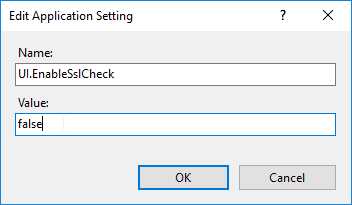
Disable Activity Manager
From Disable the visibility of running applications in the Activity Manager in Advanced Configuration at Citrix Docs: By default, the Activity Manager in Director displays a list of all the running applications and the Windows description in the title bars of any open applications for the user’s session. This information can be viewed by all administrators that have access to the Activity Manager feature in Director. For Delegated Administrator roles, this includes Full administrator, Delivery Group administrator, and Help Desk Administrator.
To protect the privacy of users and the applications they are running, you can disable the Applications tab from listing running applications.
- On the VDA, modify the registry key located at HKLM\Software\Citrix\Director\TaskManagerDataDisplayed. By default, the key is set to 1. Change the value to 0, which means the information will not be displayed in the Activity Manager.
- On the server with Director installed, modify the setting that controls the visibility of running applications. By default, the value is true, which allows visibility of running applications in the Applications Change the value to false, which disables visibility. This option affects only the Activity Manager in Director, not the VDA. Modify the value of the following setting:
UI.TaskManager.EnableApplications = false
Large Active Directory / Multiple Forests
From CTX133013 Desktop Director User Account Search Process is Slow or Fails: By default, all the Global Catalogs for the Active Directory Forest are searched using Lightweight Directory Access Protocol (LDAP). In a large Active Directory environment, this query can take some time or even time out.
If multiple forests, see Citrix Blog Post Using Citrix Director in a MultiForest Environment.
- In Information Server (IIS) Management, under the Desktop Director site, select Application Settings and add a new value called Connector.ActiveDirectory.ForestSearch. Set it to False. This disables searching any domain except the user’s domain and the server’s domain.
- To search more domains, add the searchable domain or domains in the Connector.ActiveDirectory.Domains field.
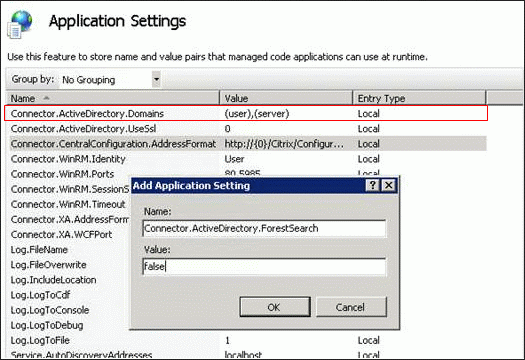
Site Groups
From Citrix Blog Post Citrix Director 7.6 Deep-Dive Part 4: Troubleshooting Machines:
If there are a large number of machines, the Director administrator can now configure site groups to perform machine search so that they can narrow down searching for the machine inside a site group. The site groups can be created on the Director server by running the configuration tool via command line by running the command:
C:\inetpub\wwwroot\Director\tools\DirectorConfig.exe /createsitegroups
Then provide a site group name and IP address of the delivery controller of the site to create the site group.
Director – Saved Filters
From Scott Osborne and Jarian Gibson at Citrix Discussions: In Director, you can create a filter and save it.
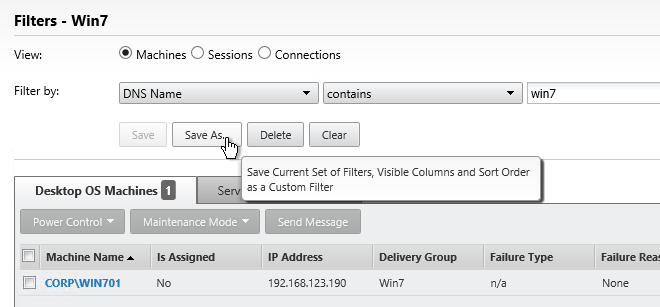

The saved filter is then accessible from the Filters menu structure.

The saved filters are stored on each Director server at C:\Inetpub\wwwroot\Director\UserData. Each user has their own saved filters. The saved filters are not replicated across Director servers.

You can instead configure multiple Director servers to store the filters on a shared UNC path: (h/t CTP Jarian Gibson)
- Create and share a folder (e.g. DirectorData).
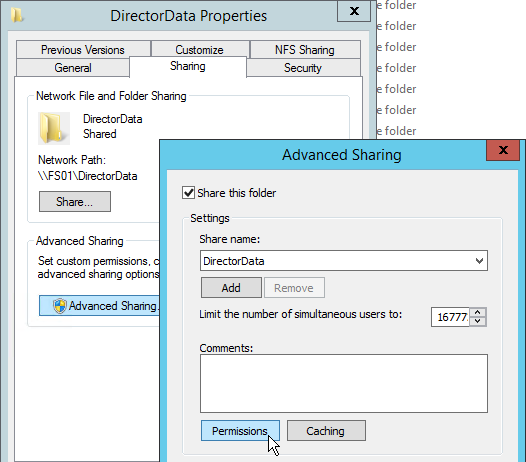
- The Director server computer accounts need Modify permission to the share.
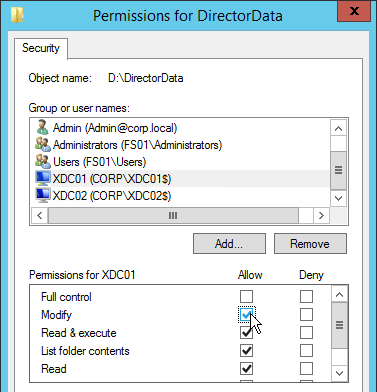
- On each Director server, run IIS Manager.
- Go to Sites > Default Web Site > Director. In the middle, double-click Application Settings.
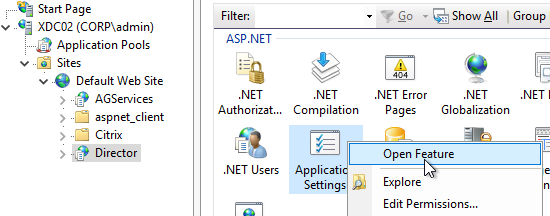
- Change the Service.UserSettingsPath setting to the UNC path of the new share.
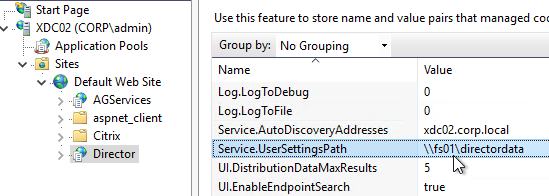
- Repeat this on other load balanced Director servers.
Director – Custom Reports
In Director 7.12 and newer, in the Trends view, there’s a Custom Reports tab that guides you through creating a custom OData Query. This tab only appears if you have XenApp/XenDesktop Platinum Edition.
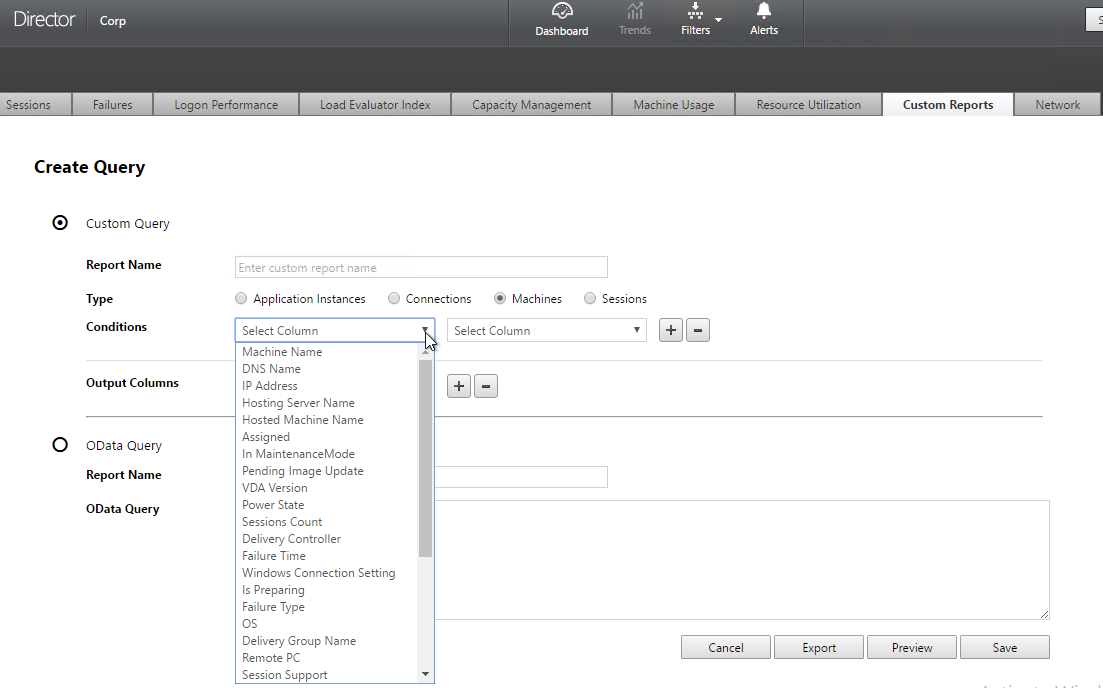
The Monitoring database contains more data than is exposed in Director. To view this data, the Monitoring service has an OData Data Feed that can be queried.
- You can use Excel to pull data from the OData Data feed. See Citrix Blog Post – Citrix Director – Analyzing the Monitoring Data by Means of Custom Reports. This particular blog post shows how to use an Excel PivotChart to display the connected Receiver versions.
- Citrix CTX211428 Using Excel to Report on Desktop Director Data uses Power Pivot.
- Or for Linqpad, see Citrix Blog Post – Creating Director Custom reports for Monitoring XenDesktop using Linqpad
- CTA David Ott XenDesktop Usage Report shows that querying OData can be slow and it’s sometimes faster to query the actual Monitoring database. Updated Report.
Use Director
See Monitor deployments at Citrix Docs.
George Spiers has a comprehensive guide of all Director 7.12 features at http://www.jgspiers.com/citrix-director/.
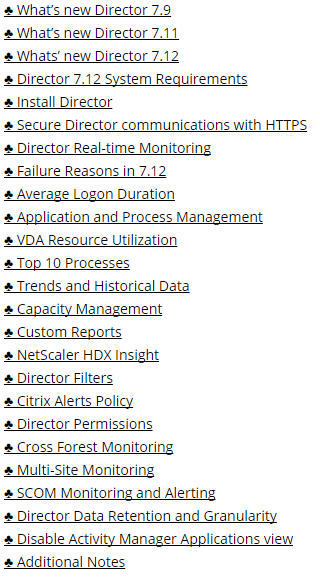
Director 7.12 adds Connection Failure Details, which is detailed in Citrix Blog Post Director 7.12: Easier Troubleshooting of Machine & Connection Failures. 💡
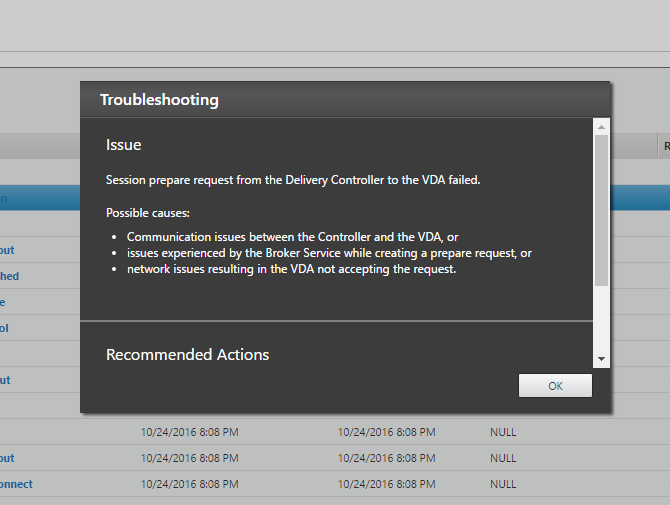
Director 7.11 adds Process Monitoring, which is detailed in Citrix Blog Post Citrix Director: CPU, Memory Usage and Process Information.

Director 7.9 added Logon Duration improvements.
Citrix Blog Post Interactive Session of Logon Duration in Citrix Director – Explained: Interactive Session Duration = Desktop Ready Event Timestamp (EventId 1000 on VDA) – User Profile Loaded Event Timestamp (EventId 2 on VDA). More details in the Blog Post.

Citrix Blog Post Director 7.6 Failure Reasons Demystified lists possible failure reasons behind an Unregistered alert, and the true meaning of failure reasons such as Connection Refused and Communication Error. It details each failure reason, defines the meanings of these failures, and lists action items that serve as a starting point for troubleshooting the specific scenario. The list is based on Director 7.6.300.
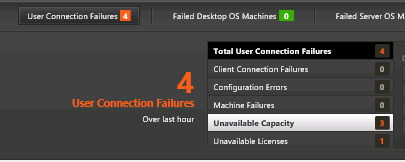
Hi Carl,
I am using Citrix Director 7.15 Enterprise Edition. Is there a way that I can get Custom Report tab enable in the environment.
Thanks.
I think it requires Premium Edition licenses.
Otherwise, you could use a reporting tool (e.g. Excel) to connect to the Monitor Service OData feed. Or pull data directly from the database.
Hello Carl,
I have installed Director 7.13. Under the Trends tab, the resource utilization is not showing any statistic sof CPU pr Memory utilization. Is there anything I need to configure to get it working ?
What version of Controller and VDAs? Director depends on these components.
What is your licensed edition?
Hello Carl,
THe Controller is 7.13 and VDA is 7.13 on few machines and 7.15 on some machines. We have platinum licensing.
Thanks,
Yogesh
Hi Carls,
We have Citrix Director Configured for XenApp 7.12 environment. I have added Xenapp 7.6 site in Citrix Director. Everything is working fine but Resource Utilization and Custom report is showing grayed out for XenApp 7.6 site.
Yep. I believe those features require a newer version of Delivery Controller.
Hi Carls,
We have configured Citrix Director for Xenapp 7.12 environment. We have another XenApp 7.6 environment as well. Can we add XenApp 7.6 site in the Citrix Director that we have configured of XenApp 7.12 environment If Yes how we will do that.
Yep. https://www.carlstalhood.com/director-7-12/#multiplesites
Hi,
I’m trying to use Windows Integrated Authentication :
I have one server for Director + Broker
I configured IIS as stated on edocs,
I added SPN http/myserver.mydomain mydomain\myserver
I added director site to intranet site on clients
It doesn’t work unless I use local IE on director server
any help on this one
Could you confirm if you have added Trust Delegation as mentioned in https://www.citrix.com/blogs/2016/01/08/citrix-director-7-7-using-integrated-windows-authentication-to-log-in/
I noticed in #directortweaks that the screenshots refer to “Connector.ActiveDirectory.ForestSearch” and “Connector.ActiveDirectory.Domain” while the text leaves out the “Connector” part. That’s a bit confusing especially since the Connector.ActiveDirectory.ForestSearch is not a standard value.
Carl,
I am a brand new install of XA/XD 7.12. Director 7.12 seems to be running extremely slow and not displaying correctly. I did not install it on the delivery controller, is this an issue?
The only time it seems to run without an issue is if I run it locally on the server. Running it locally and as a published application is where the problem arises. All other published applications run without any performance issues.
Infrastructure: VMWare, Server 2012 R2, XenApp 7.12 for the whole environment.
Any guidance you could provide would be greatly appreciated.
Thanks,
Chris
I finally figured it out. Even though I did not have compatibility view enabled for the web page, I overlooked a setting that was enabled and caused the director page to be displayed in compatibility view, “Display Intranet Sites in Compatibility View”. Unchecked that and all is working as it should.
Hi Carl, is there any benefit regarding the connected session monitor in director, because from my point view there is a huge delay in fact of managing the connected user sessions. Or do you have any idea to fix the display issue?
At the moment we are using XenDesktop 7.9 Enterprise Edition.
Thank you in advance.
Best regards
Tom
Are you saying that sessions are missing? Or data is missing from the session? Try posting your question to http://discussions.citrix.com. Citrix certainly makes improvements in each release so upgrading might help.
Hi,
Thank you for the post.
Is it possible to see the report for (session report for last 24 hours) two sites in single screen in this version?
Director currently doesn’t combine historical data from multiple sites, but this info is available on per site basis
does this custom report feature require xendesktop and xenapp to be licensed with Platinum edition?
Yes. I should have noted that. I’ll do that now. Thanks.